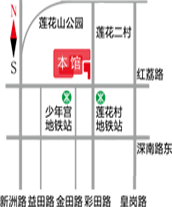
- Shenzhen has a good design atmosphere - Interview with Mr. He Jie, Vice President of Tsinghua Academy of Fine Arts
-
Guan Shanyue
Q: Tsinghua Academy of Fine Arts has always had friendly exchanges with the design community in Shenzhen. Dean He is also familiar with the design community in Shenzhen. Could you please share your views on Shenzhen from the perspectives of design and culture. Last November, Shenzhen successfully applied for the "Design Capital" and became the first city in China. What is your opinion on this event.
Answer: We have always been very interested in Shenzhen. Since the first graphic design exhibition in Shenzhen in 1992, we have been paying attention to Shenzhen's graphic design. Later, around 1997, we held an exhibition in Angio, France, which was a design festival in the city. Our art institute and Shenzhen Graphic Design Association formed a group to send works to participate in the exhibition. This may be our earliest cooperation with Shenzhen, and since then, we have also had frequent business exchanges and cooperation. So far, graphic design in Shenzhen has represented the best level in China, and the characteristic of Shenzhen design is that its main force is in society, with industry associations, many excellent design companies, and professional designers. Their overall level is relatively average. While doing commercial design, they also promote avant-garde design concepts to society, promote social awareness of design, and promote the formation of a design culture atmosphere. In this regard, Shenzhen is at the forefront of the country. The design activities in Shenzhen are also very frequent, and your graphic design exhibitions in China are still ongoing and have a significant impact. This time, Shenzhen has successfully become the "design capital", which also reflects the social attention to design and the government's high attention to design. Tsinghua Academy of Fine Arts also hopes to use Shenzhen as a platform to engage in specific cooperation with Shenzhen. Recently, we have been discussing specific cooperation matters with the cultural department in Shenzhen. We want to establish a Tsinghua Academy of Fine Arts student internship base in Shenzhen, because design students have the characteristic of participating in more social practice, including requiring undergraduate students to learn and study design methods abroad. Sending students to cities like Shenzhen for internships with a strong design culture atmosphere and involving them in the specific work of good design companies is very helpful for their rapid professional growth. Some students can even stay in Shenzhen for employment, of course, Shenzhen is not only good at graphic design, but also in clothing, environmental arts, industrial design, and other fields.
Q: The National Art Exhibition has been held for the third time now. Could you please talk about the development or changes in Chinese art and design reflected in the exhibitions over the past decade.
Answer: The China Artists Association has established art committees in the field of design, which have basically covered all aspects of the design field. Some art committees were established earlier, while others were relatively late. The graphic design art committee has been established for five years, and the clothing industry was only established last year. It can be said that these art committees have led and promoted the development of Chinese design art, because there is currently no overall industry association in the design field in China that can integrate resources from all aspects. From the works of this exhibition, I believe there has been significant progress compared to the past, with some excellent works emerging. China's design education is relatively developed, so there are more works exhibited by colleges and universities. This is different from other cities. Shenzhen's design subject is in society, and there are more works exhibited by frontline designers. This also reflects that Shenzhen has a good design atmosphere. I think everyone will not have different opinions on the above views.
Q: There is increasing criticism of excessive design in society nowadays, such as the book binding made by designers, which many readers find inconvenient to read. What is your opinion on this issue.
Answer: The problem of excessive design is not only reflected in book binding, but also in packaging design and even image design, which is certainly not advisable. Design is about solving problems, and primarily achieving its functions. Therefore, our design thinking should also reflect sustainable development. China is a country with a large population and scarce resources, and wasting resources is definitely not advisable. The issue of reading books just mentioned causes a waste of time and resources for people. When we look at some internationally renowned design reviews, we feel that often a simple design can win a gold medal, which also reflects this concept. In order to oppose excessive design, we have even made very specific regulations in packaging design, requiring that the maximum space between packaging boxes and containers should not exceed much, etc. Now, it should be said that we have basically returned to the essence of design. However, we cannot only focus on functionality. We are more inclined to pursue visual aesthetics, symbolism, and cultural connotations. Because the world is diverse, diverse cultures shape the uniqueness of design languages in various countries, thus also reflecting national identity. The phenomenon of imitation in the initial stage should have passed, and Chinese design is already quite mature.
Q: Could Dean He talk about how well the organizational service work undertaken by Shenzhen has been done.
Answer: During the initial evaluation stage in Beijing, we felt that Shenzhen's organizational and service work was excellent and meticulous in terms of procedures, methods, and other aspects. The service work was done very well, so the judges all felt that the re evaluation work went smoothly. This not only reflects the importance that Shenzhen attaches to exhibitions, but also reflects the high professional quality of Shenzhen's leaders and a large number of personnel engaged in related work. I think having a national art exhibition in Shenzhen has the following advantages:
1. Shenzhen has an open perspective and is geographically adjacent to Hong Kong, Macao, and Taiwan, making it a great platform for communication.
2. There is a group of persistent, pursuing, and design oriented professionals in Shenzhen who pay close attention to domestic and international design trends and are enthusiastic about participating in and organizing exhibitions and activities related to design.
3. Shenzhen has a well-developed industry related to design, for example, the printing industry related to graphic design is the best in China.
4. Shenzhen is a young city, so she has no bias and will create opportunities for design talents from all over the world. Finally, thanks to the strong support and promotion of the Shenzhen Municipal Government, it is rare to see development design as a cultural policy for urban development in China.



